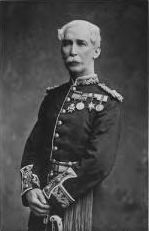John Wellesley Thomas
Sir John Thomas | |
|---|---|
 | |
| Born | 22 May 1822[1] Bath, Somerset |
| Died | 6 February 1908 (aged 85) |
| Buried | |
| Allegiance | United Kingdom |
| Service | British Army |
| Years of service | 1839–1881 |
| Rank | Lieutenant-General |
| Commands | 67th (South Hampshire) Regiment of Foot |
| Battles / wars | |
| Awards | |
| Other work | Colonel of the Hampshire Regiment (1893–1908) |
| This article is part of a series on the |
| Eureka Rebellion |
|---|
 |
|
|
Lieutenant-General Sir John Wellesley Thomas, KCB (22 May 1822 – 6 February 1908) was a distinguished British military officer who served in Afghanistan, Australia, and China. He was the commander of the British military and police forces that quelled the rebellion at the Eureka Stockade in Ballarat, Victoria, in 1854.
Thomas, who was an elder son of the Admiral Jennings Thomas, was born in 1822. He received his first commission in 1839 and served with the 40th Regiment of Foot in Afghanistan in 1841–42, during the First Anglo-Afghan War. He was present at the action of Maharajpur when he was severely wounded. His decorations for those engagements included the clasps "Kandahar, Kabul, Ghuznee" and the bronze star for Maharajpur. In 1854, he commanded detachments in the operations in Australia against rebellious minors on the Ballarat goldfields. In North China, he served with the 67th Regiment of Foot and was wounded when in command of a half-battalion attacking the North Taku Fort in 1860. For this campaign, he was mentioned in despatches and appointed a Companion of the Order of the Bath.[2] Two years later, when being promoted to colonel,[3] he commanded the 67th Regiment and a brigade at the second capture of Khading in the Taiping Rebellion. This was his last active service. He was promoted to major general in 1877,[4] and retired in 1881 with the honorary rank of lieutenant general.[5] In 1882, he was appointed to the colonelcy of the Hampshire Regiment,[6] and in 1904 was made a Knight Commander of the Order of the Bath.[7][8]
Thomas died on 8 February 1908,[9] and was buried at Kensal Green, London.[8]
References
- ^ Addison, Henry Robert; Oakes, Charles Henry; Lawson, William John; Sladen, Douglas Brooke Wheelton (1905). Who's Who. A. & C. Black. p. 1590.
- ^ "No. 22485". The London Gazette. 1 March 1861. pp. 1006–1007.
- ^ "No. 22804". The London Gazette. 8 January 1864. p. 100.
- ^ "No. 24508". The London Gazette. 2 October 1877. p. 5459.
- ^ "No. 25039". The London Gazette. 18 November 1881. p. 5620.
- ^ "No. 26476". The London Gazette. 16 January 1894. p. 316.
- ^ "No. 27688". The London Gazette (Supplement). 21 June 1904. p. 4007.
- ^ a b "Obituary". The Times. 8 February 1908. p. 10. Retrieved 23 May 2010.
- ^ "Index entry". FreeBMD. ONS. Retrieved 23 May 2010.
- 1822 births
- 1908 deaths
- Military personnel from Somerset
- Knights Commander of the Order of the Bath
- 67th Regiment of Foot officers
- 40th Regiment of Foot officers
- British Army lieutenant generals
- British Army personnel of the Second Opium War
- British military personnel of the Taiping Rebellion
- British military personnel of the First Anglo-Afghan War
- Burials at Kensal Green Cemetery
- Governors of Natal
- Eureka Rebellion
- Battle of the Eureka Stockade
